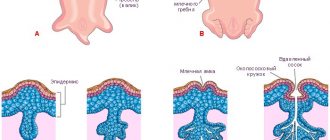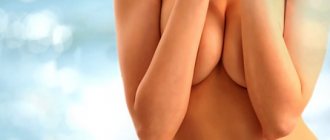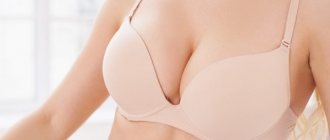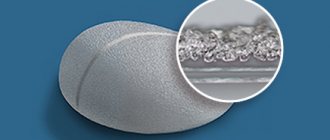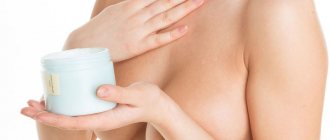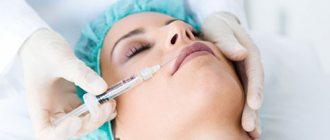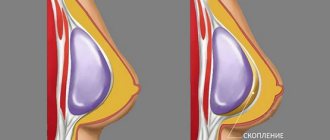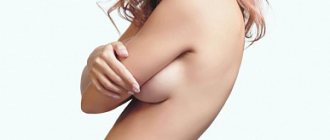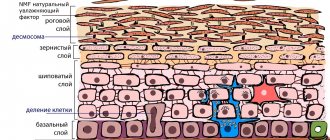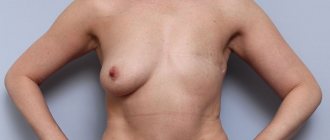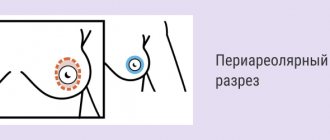During puberty, many girls are embarrassed by their small bust size, which becomes the reason for the development of many complexes. However, today there are many remedies that help enlarge breasts during adolescence. To do this, you need to make adjustments to your diet and perform special physical exercises.
If the bust does not begin to grow even at the age of 15-16, you should consult a doctor - perhaps the reason lies in a hormonal imbalance.
Features of physiology
The mammary glands begin to develop during puberty. Most often, the first manifestations of breast enlargement are observed at 10-11 years of age. But for a number of girls this happens later – at 13 years old. Most often, the bust begins to increase a year before the start of menstruation.
Breast development usually takes 3-5 years, but for some girls this process continues much longer. As a rule, the development of the bust is completed at the age of 15-16, but some girls find that this process is delayed until the age of 19-25.
That is why the popular question of how to enlarge a bust at 13 years old is not considered relevant. You shouldn't expect a major change in size at 15-16 years old. However, it is still possible to slightly enlarge your breasts.
How do women's breasts work?
Nipples can come in all sorts of colors, from black to almost transparent pink. Most of them protrude slightly from the chest, but some are recessed. inside. Over time, they can unfold and bulge outward. Having two nipples that look completely different is common. There are no completely symmetrical nipples, that is, identical on both sides of the body.
The nipples are usually soft to the touch and sac-like, but sometimes become firm. They become denser and can stick out strongly. This happens for various reasons. For example, when it is cold, when a woman is feeding a baby, when she is excited or when she is tickled and gets goosebumps.
The ring around the nipples has a beautiful Latin name - areola (translated from Latin areola - platform). It gradually becomes wider and often becomes darker in color along with the nipples during puberty. It depends on your skin tone and the color of your areola originally. Over time, as on the pubic area and in the armpits, longer, coarse hair begins to grow on it, often appearing on the edge of the areola.
Basic methods of enlargement
- Diet
Women's breasts are approximately 85% fatty tissue. Therefore, the main method of increase is weight gain. Thanks to this, the breasts will get better, which means their size will increase. To achieve such results, it is enough to increase the calorie content of your diet.
- Hormones
Another reason for insufficient breast size in adolescence is considered to be an imbalance of hormones. In this case, the girl’s body produces too little estrogen, which helps to enlarge the breasts. At the same time, too much testosterone is produced, which interferes with the development of the bust. In such cases, hormonal drugs are usually used, but only a doctor should select them.
- Physical exercise
Exercise cannot enlarge breasts because they do not involve muscle tissue. With the help of sports, it is possible to build up the muscles that are located under the bust. Thanks to their strengthening, the breasts move forward a little, which makes them more toned. Also, regular exercise has a positive effect on posture, which improves the appearance of the bust.
- Massage
Massaging your breasts is very beneficial. This should be done three times a day for several minutes. Thanks to this, it is possible to enlarge the bust, since the procedure normalizes blood circulation and promotes the supply of nutrients to the mammary glands.
How do breasts grow in girls?
For the vast majority of girls, the first thing that changes during adolescence is their breasts. It all starts with swollen nipples. Under them you can feel a hard and painful lump, which you can roll between your fingers. Often at first it can only be detected on one side.
Over time, as the mammary gland grows, sleeping on your stomach will become uncomfortable, and the friction of clothes on your skin will cause pain. And of course, a push to the chest will be very painful.
From the moment the first dense lumps appear, it usually takes several months until they become something larger. The breasts will begin to enlarge slightly so that soft swelling can be seen and felt outside the nipple circumference. They will continue to grow until the breasts are fully formed in about two years.
Breast size varies greatly among women and depends on heredity. In some families women have large breasts, in others they have small breasts.
The fact that one mammary gland is larger than the other is a common phenomenon, and during adolescence this difference can be especially noticeable until they become equal. However, for most women, the left and right breasts are slightly different in size. For some very strange reason, most often the left one is larger.
Boys can grow breasts too
Women and men are more alike than you think. During puberty, half of the boys' mammary glands will also enlarge under the influence of hormones! We doctors call this phenomenon gynecomastia. For most young men, everything gets better on its own within two years.
Features of diet preparation
To enlarge your breasts at the age of 13, you need to eat certain categories of foods:
- Healthy fats
Since the bust includes predominantly adipose tissue, it is recommended to consume monounsaturated fats at 13-16 years of age. These include nuts, avocado, olive oil. At the same time, you should not eat unhealthy fats, which are mostly deposited on the stomach and hips. In addition, such products provoke an increase in cholesterol and cause various health problems.
- Products containing estrogen
This is a female sex hormone that helps to enlarge breasts. To achieve the required results, at the age of 13-16 you need to eat red beans, pumpkin, garlic, and eggplant. Equally beneficial is eating peas and flaxseeds. In this case, it is better to exclude products containing testosterone. You should not eat foods containing carbohydrates - white rice, bread, pastries.
- Protein food
To increase your bust size, you need to pay attention to foods high in protein. To do this, it is recommended to eat nuts, eggs, and milk. At the age of 13-16, low-fat fish and chicken are very useful.
- Fruits and vegetables
These categories of foods help balance testosterone levels in the blood. At the same time, the content of anthocyanins and antioxidants helps reduce the negative effects of free radicals on the body and promotes the restoration of damaged tissues.
It is also useful to eat berries - for example, blueberries. The daily menu of 13-16 year old girls should include dates, cherries, and apples. These products contain a lot of estrogens, which helps to increase the size of the bust.
- Composition based on milk and papaya juice
The beneficial substances that are present in these products have a great effect on the breast size of 15-year-old girls. However, the desired effect can be achieved only with systematic use. It is also quite possible to simply consume papaya fruit instead of juice.
According to some data, up to 92% of women of reproductive age suffer from pathology of the mammary glands (MG), and malignant processes are detected in 10%. The problem does not arise overnight. For many, it lasts from adolescence, starting with benign hormonally dependent diseases.
Breast diseases in teenage girls are common, but not so often diagnosed. Some studies show that every 10th schoolgirl has problems with the mammary gland at the stage of its formation. Meanwhile, many girls are embarrassed to tell their mother or doctor about their complaints, and mothers do not consider it necessary to contact a gynecologist for preventive purposes. Gynecologists, in turn, must examine the mammary glands of all patients and refer them to a mammologist if something is alarming.
Anomalies and disorders of breast development
Hypoplasia is a developmental deficiency that may be a consequence of congenital absence or underdevelopment of glandular tissue, a systemic disorder (for example, malnutrition, Crohn's disease), radiation therapy, congenital adrenal dysfunction, gonadal dysgenesis, hypogonadotropic hypogonadism, etc.
Amastia is a complete absence of glandular tissue, most often one-sided, and is part of the structure of congenital Poland syndrome.
Polymastia is an abnormally located area of glandular tissue that forms an additional protrusion in the chest area, diagnosed in 5% of girls).
Polythelia is an increase in the number of nipples, occurs in 1–1.5% of cases and is hereditary.
Macromastia is hypertrophy of the mammary glands.
Asymmetry - occurs in 10–25% of teenage girls, the etiology is unknown, there are only theories (endocrine, iatrogenic, as a result of trauma to the mammary gland in childhood); According to some authors, asymmetric breast development can be considered as a normal variant, however, there are indications that breast asymmetry is a risk factor for the development of fibrocystic disease.
Inverted nipple - occurs in 2-4% of teenage girls and is caused by milk ducts that are too short.
Causes of mastalgia
Very often, girls and women experience pain in the breast (mastalgia). Some people experience pain only before menstruation, while others experience pain almost constantly. More than half of teenage girls who are familiar with discomfort in the breast are diagnosed with mastopathy during examination.
Mastopathy is a collective term that describes cystic and fibrotic changes in the breast, characterized by a violation of the ratio of epithelial and connective tissue. Currently, it is believed that mastopathy occurs due to hormonal imbalance. Prevalence among adolescent girls is 4–8%.
Risk factors: hereditary predisposition, neuroendocrine disorders, obesity, prolonged mental stress, early menarche (up to 12 years), menstrual irregularities, gynecological diseases, thyroid diseases, inflammatory diseases of the breast, injuries (including piercing and tattoos), bad habits .
Mastitis is an inflammatory process in the breast caused by the ingress of dangerous microbes.
Mastitis occurs especially often after nipple piercing and tattooing, which have recently become very popular among teenagers. At the same time, nipple piercing is a risk factor not only for infectious mastitis, but also for malignant transformation. Cases of the development of Paget's disease, an aggressive cancer affecting the nipple area, including in boys, have been described.
Malignant breast tumors are rare in adolescents; cancer and sarcoma are diagnosed in 1% of young patients. A significant increase in the risk of breast cancer is observed with the proliferative form of mastopathy and with a hereditary predisposition (carriage of the BRCA1 and BRCA2 genes); the risk of cancer in carriers of these genes is 60–80%. The most common malignant diseases of the breast in adolescents are metastatic lesions due to leukemia, rhabdomyosarcoma, leukemia, lymphoma, and neuroblastoma.
Benign formations
Breast cyst is the most common pathological formation, diagnosed in 3–25% of adolescent girls. The cause is considered to be impaired absorption of postnatal gland secretions. Research results indicate that hyperestrogenemia, hypercortisolism and hypothyroidism are important in the pathogenesis of cystic formations of the breast. Some authors tend to consider cysts the initial stage of fibrocystic mastopathy. Post-traumatic cysts are also found.
Fibroadenoma ranks second in frequency - the prevalence ranges from 4% to 63%, in 10-15% of cases multiple fibroadenomas (fibroadenomatosis) occur. The reason may be the spasmodic progression of puberty.
Diagnostics
Ultrasound. Basic instrumental method for studying breast cancer in young patients. This is a simple and safe method in terms of radiation exposure with the possibility of repeated use.
X-ray mammography, used in mass (screening) examinations of women and aimed at early detection of breast cancer, cannot be used for these purposes in adolescents and girls due to the predominance of glandular tissue, which is why the mammary gland is radiologically more “dense” than in an adult woman, in which adipose tissue predominates. In addition, breast tissue of children and adolescents is highly sensitive to radiation exposure.
Physical exercise
Swimming is beneficial for girls aged 13-16 years old. You should also do the following exercises for your chest:
- Sit on your knees, point your toes out and lower yourself little by little until your thighs touch your chest. Extend your arms, then lower yourself down until your head and palms touch the floor. You need to hold the bend for half a minute.
- Place your hands on the floor, place your toes on the floor, and do flexion and extension of your upper limbs. In this case, it is important to bring the chest well towards the floor and raise the pelvic area. The torso should be straight. Do this exercise 15-20 times
- Lie on the floor, bend your lower limbs, take dumbbells weighing 2 kg, pull them up and lower them to your chest. Do 15-20 reps
- Lie on your stomach, straighten your lower limbs, bend your arms, and place your palms on the floor. Your arms should be smoothly straightened, lifting your upper body. The face should be directed upward. You should remain in this position for half a minute. Do 15-20 repetitions
If exercises are done systematically at the age of 13-16, the muscle tissue of the chest will strengthen, which will give the bust elasticity and add volume.
Until what age does breast growth continue?
When a girl's breasts begin to grow, there is no need to worry about her health and the development of her reproductive system. These changes should be accepted as due. This is a new stage in her life. Mom should make sure that the girl does not experience complexes, but rather is proud of her growing up.
The mammary glands are fully formed by the age of 20, but for some this process may be faster. Heredity will help you determine your stage of growing up. If a mother or grandmother has developed mammary glands by the age of 18, then the girl will most likely have the same. Pregnancy has a great influence on breast formation. Many girls between the ages of 18 and 20 are already pregnant. The complete formation of the endocrine glands is influenced by: place of residence, health, nationality, body shape and weight.
What should you not do?
It is important for 15-year-old girls to take into account that all kinds of dietary supplements, ointments and other products of unknown origin can cause great harm to health. Most of these products actually increase bust size for a short time. This is achieved due to the content of estrogen in such products.
However, the dosage of the hormonal components is usually not known. Therefore, the effect of such drugs on the body of 13-16 year old girls is impossible to predict. The use of such drugs often causes hormonal disorders and bleeding. In addition, breast size usually decreases after using such products.
Interesting Facts
In the South and East, women mature faster, their mammary glands form earlier. Small breasts at the age of 14 are observed in girls who neglect physical exercise. The active growth of the glands is influenced by a healthy and correct influence. Lack of nutrients leads to its slow development.
Despite the claims of many girls that cabbage can affect breast growth, this is just a myth. Neither legumes nor crispy cabbage will help you achieve a voluminous bust.
In what cases should you consult a doctor?
If the girl is already 15-17 years old, and development has not begun, she needs to visit a specialist - a gynecologist or mammologist. In some cases, consultation with an endocrinologist may also be required.
First of all, a specialist should examine the breast and determine whether there is cause for concern. If insufficient development of the mammary glands is observed, additional examinations are prescribed. Thanks to this, it is possible to determine the causes of this condition.
Breast enlargement in girls during the developmental period can be carried out exclusively with the help of food and exercise. At the same time, the use of hormonal drugs and other medications is strictly prohibited - only a doctor can prescribe them.
What happens to a girl's body during puberty?
When a girl grows up, she experiences an enlargement of the mammary glands, the nipple circles protrude slightly, after which the breasts begin to take on their shape. Genetic predisposition determines what type of breast a girl will have. Most often the shape and size will be the same as the mother's.
Initially, the breasts at the age of 14 have a conical shape, then gradually become rounded. After the formation of the glands, the teenager develops hair in the armpits and genital area. The endocrine glands are fully formed over several years.
